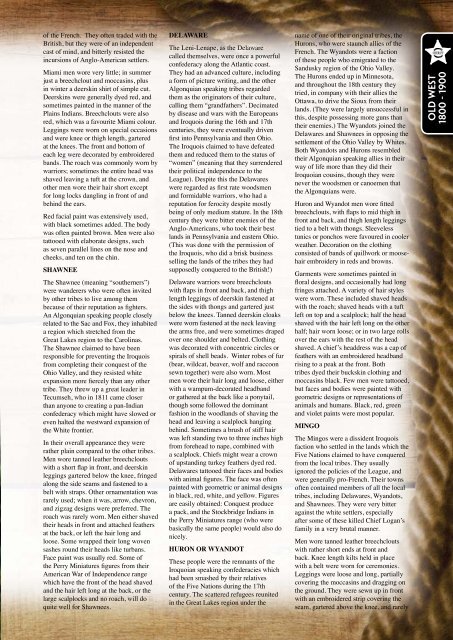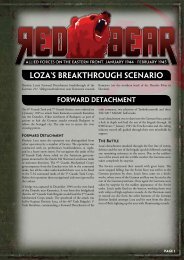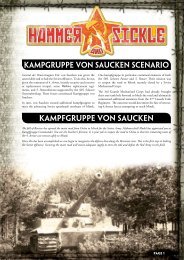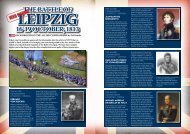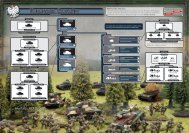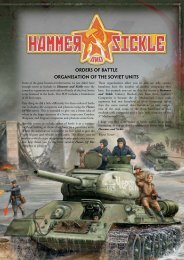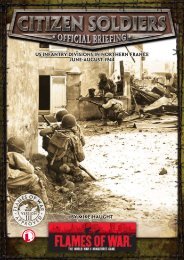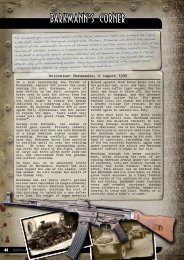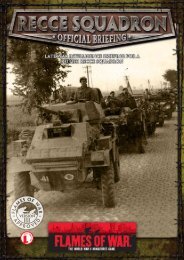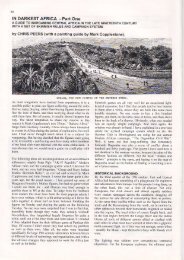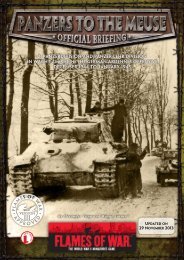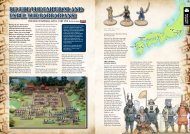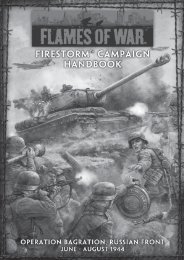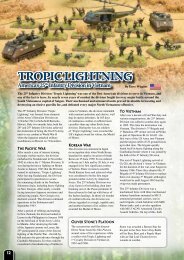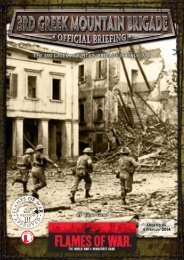INDIAN TRIBES OF THE EASTERN wOODLANDS ... - Flames of War
INDIAN TRIBES OF THE EASTERN wOODLANDS ... - Flames of War
INDIAN TRIBES OF THE EASTERN wOODLANDS ... - Flames of War
Create successful ePaper yourself
Turn your PDF publications into a flip-book with our unique Google optimized e-Paper software.
<strong>of</strong> the French. They <strong>of</strong>ten traded with the<br />
British, but they were <strong>of</strong> an independent<br />
cast <strong>of</strong> mind, and bitterly resisted the<br />
incursions <strong>of</strong> Anglo-American settlers.<br />
Miami men wore very little; in summer<br />
just a breechclout and moccasins, plus<br />
in winter a deerskin shirt <strong>of</strong> simple cut.<br />
Deerskins were generally dyed red, and<br />
sometimes painted in the manner <strong>of</strong> the<br />
Plains Indians. Breechclouts were also<br />
red, which was a favourite Miami colour.<br />
Leggings were worn on special occasions<br />
and were knee or thigh length, gartered<br />
at the knees. The front and bottom <strong>of</strong><br />
each leg were decorated by embroidered<br />
bands. The roach was commonly worn by<br />
warriors; sometimes the entire head was<br />
shaved leaving a tuft at the crown, and<br />
other men wore their hair short except<br />
for long locks dangling in front <strong>of</strong> and<br />
behind the ears.<br />
Red facial paint was extensively used,<br />
with black sometimes added. The body<br />
was <strong>of</strong>ten painted brown. Men were also<br />
tattooed with elaborate designs, such<br />
as seven parallel lines on the nose and<br />
cheeks, and ten on the chin.<br />
SHAWNEE<br />
The Shawnee (meaning “southerners”)<br />
were wanderers who were <strong>of</strong>ten invited<br />
by other tribes to live among them<br />
because <strong>of</strong> their reputation as fighters.<br />
An Algonquian speaking people closely<br />
related to the Sac and Fox, they inhabited<br />
a region which stretched from the<br />
Great Lakes region to the Carolinas.<br />
The Shawnee claimed to have been<br />
responsible for preventing the Iroquois<br />
from completing their conquest <strong>of</strong> the<br />
Ohio Valley, and they resisted white<br />
expansion more fiercely than any other<br />
tribe. They threw up a great leader in<br />
Tecumseh, who in 1811 came closer<br />
than anyone to creating a pan-Indian<br />
confederacy which might have slowed or<br />
even halted the westward expansion <strong>of</strong><br />
the White frontier.<br />
In their overall appearance they were<br />
rather plain compared to the other tribes.<br />
Men wore tanned leather breechclouts<br />
with a short flap in front, and deerskin<br />
leggings gartered below the knee, fringed<br />
along the side seams and fastened to a<br />
belt with straps. Other ornamentation was<br />
rarely used; when it was, arrow, chevron,<br />
and zigzag designs were preferred. The<br />
roach was rarely worn. Men either shaved<br />
their heads in front and attached feathers<br />
at the back, or left the hair long and<br />
loose. Some wrapped their long woven<br />
sashes round their heads like turbans.<br />
Face paint was usually red. Some <strong>of</strong><br />
the Perry Miniatures figures from their<br />
American <strong>War</strong> <strong>of</strong> Independence range<br />
which have the front <strong>of</strong> the head shaved<br />
and the hair left long at the back, or the<br />
large scalplocks and no roach, will do<br />
quite well for Shawnees.<br />
DELAWARE<br />
The Leni-Lenape, as the Delaware<br />
called themselves, were once a powerful<br />
confederacy along the Atlantic coast.<br />
They had an advanced culture, including<br />
a form <strong>of</strong> picture writing, and the other<br />
Algonquian speaking tribes regarded<br />
them as the originators <strong>of</strong> their culture,<br />
calling them “grandfathers”. Decimated<br />
by disease and wars with the Europeans<br />
and Iroquois during the 16th and 17th<br />
centuries, they were eventually driven<br />
first into Pennsylvania and then Ohio.<br />
The Iroquois claimed to have defeated<br />
them and reduced them to the status <strong>of</strong><br />
“women” (meaning that they surrendered<br />
their political independence to the<br />
League). Despite this the Delawares<br />
were regarded as first rate woodsmen<br />
and formidable warriors, who had a<br />
reputation for ferocity despite mostly<br />
being <strong>of</strong> only medium stature. In the 18th<br />
century they were bitter enemies <strong>of</strong> the<br />
Anglo-Americans, who took their best<br />
lands in Pennsylvania and eastern Ohio.<br />
(This was done with the permission <strong>of</strong><br />
the Iroquois, who did a brisk business<br />
selling the lands <strong>of</strong> the tribes they had<br />
supposedly conquered to the British!)<br />
Delaware warriors wore breechclouts<br />
with flaps in front and back, and thigh<br />
length leggings <strong>of</strong> deerskin fastened at<br />
the sides with thongs and gartered just<br />
below the knees. Tanned deerskin cloaks<br />
were worn fastened at the neck leaving<br />
the arms free, and were sometimes draped<br />
over one shoulder and belted. Clothing<br />
was decorated with concentric circles or<br />
spirals <strong>of</strong> shell beads. Winter robes <strong>of</strong> fur<br />
(bear, wildcat, beaver, wolf and raccoon<br />
sewn together) were also worn. Most<br />
men wore their hair long and loose, either<br />
with a wampum-decorated headband<br />
or gathered at the back like a ponytail,<br />
though some followed the dominant<br />
fashion in the woodlands <strong>of</strong> shaving the<br />
head and leaving a scalplock hanging<br />
behind. Sometimes a brush <strong>of</strong> stiff hair<br />
was left standing two to three inches high<br />
from forehead to nape, combined with<br />
a scalplock. Chiefs might wear a crown<br />
<strong>of</strong> upstanding turkey feathers dyed red.<br />
Delawares tattooed their faces and bodies<br />
with animal figures. The face was <strong>of</strong>ten<br />
painted with geometric or animal designs<br />
in black, red, white, and yellow. Figures<br />
are easily obtained: Conquest produce<br />
a pack, and the Stockbridge Indians in<br />
the Perry Miniatures range (who were<br />
basically the same people) would also do<br />
nicely.<br />
HURON OR WyANDOT<br />
These people were the remnants <strong>of</strong> the<br />
Iroquoian speaking confederacies which<br />
had been smashed by their relatives<br />
<strong>of</strong> the Five Nations during the 17th<br />
century. The scattered refugees reunited<br />
in the Great Lakes region under the<br />
name <strong>of</strong> one <strong>of</strong> their original tribes, the<br />
Hurons, who were staunch allies <strong>of</strong> the<br />
French. The Wyandots were a faction<br />
<strong>of</strong> these people who emigrated to the<br />
Sandusky region <strong>of</strong> the Ohio Valley.<br />
The Hurons ended up in Minnesota,<br />
and throughout the 18th century they<br />
tried, in company with their allies the<br />
Ottawa, to drive the Sioux from their<br />
lands. (They were largely unsuccessful in<br />
this, despite possessing more guns than<br />
their enemies.) The Wyandots joined the<br />
Delawares and Shawnees in opposing the<br />
settlement <strong>of</strong> the Ohio Valley by Whites.<br />
Both Wyandots and Hurons resembled<br />
their Algonquian speaking allies in their<br />
way <strong>of</strong> life more than they did their<br />
Iroquoian cousins, though they were<br />
never the woodsmen or canoemen that<br />
the Algonquians were.<br />
Huron and Wyandot men wore fitted<br />
breechclouts, with flaps to mid thigh in<br />
front and back, and thigh length leggings<br />
tied to a belt with thongs. Sleeveless<br />
tunics or ponchos were favoured in cooler<br />
weather. Decoration on the clothing<br />
consisted <strong>of</strong> bands <strong>of</strong> quillwork or moosehair<br />
embroidery in reds and browns.<br />
Garments were sometimes painted in<br />
floral designs, and occasionally had long<br />
fringes attached. A variety <strong>of</strong> hair styles<br />
were worn. These included shaved heads<br />
with the roach; shaved heads with a tuft<br />
left on top and a scalplock; half the head<br />
shaved with the hair left long on the other<br />
half; hair worn loose; or in two large rolls<br />
over the ears with the rest <strong>of</strong> the head<br />
shaved. A chief’s headdress was a cap <strong>of</strong><br />
feathers with an embroidered headband<br />
rising to a peak at the front. Both<br />
tribes dyed their buckskin clothing and<br />
moccasins black. Few men were tattooed,<br />
but faces and bodies were painted with<br />
geometric designs or representations <strong>of</strong><br />
animals and humans. Black, red, green<br />
and violet paints were most popular.<br />
MINGO<br />
The Mingos were a dissident Iroquois<br />
faction who settled in the lands which the<br />
Five Nations claimed to have conquered<br />
from the local tribes. They usually<br />
ignored the policies <strong>of</strong> the League, and<br />
were generally pro-French. Their towns<br />
<strong>of</strong>ten contained members <strong>of</strong> all the local<br />
tribes, including Delawares, Wyandots,<br />
and Shawnees. They were very bitter<br />
against the white settlers, especially<br />
after some <strong>of</strong> these killed Chief Logan’s<br />
family in a very brutal manner.<br />
Men wore tanned leather breechclouts<br />
with rather short ends at front and<br />
back. Knee length kilts held in place<br />
with a belt were worn for ceremonies.<br />
Leggings were loose and long, partially<br />
covering the moccasins and dragging on<br />
the ground. They were sewn up in front<br />
with an embroidered strip covering the<br />
seam, gartered above the knee, and rarely<br />
OLD west<br />
1800 - 1900


